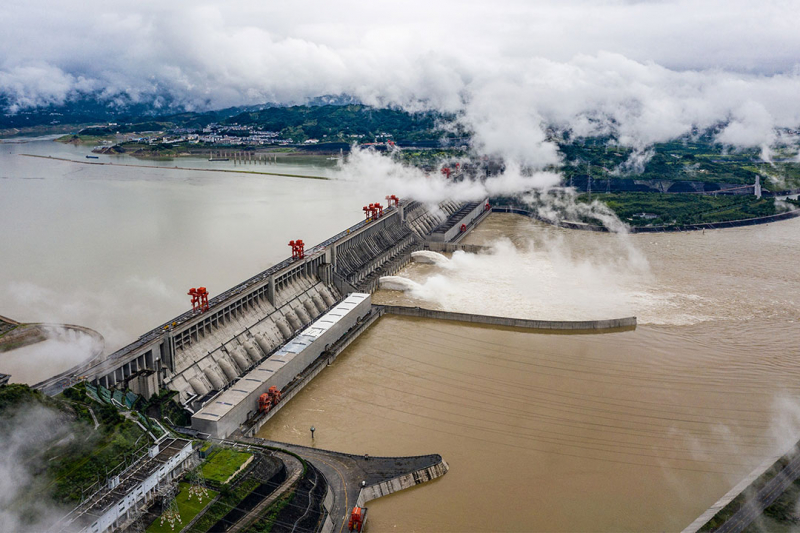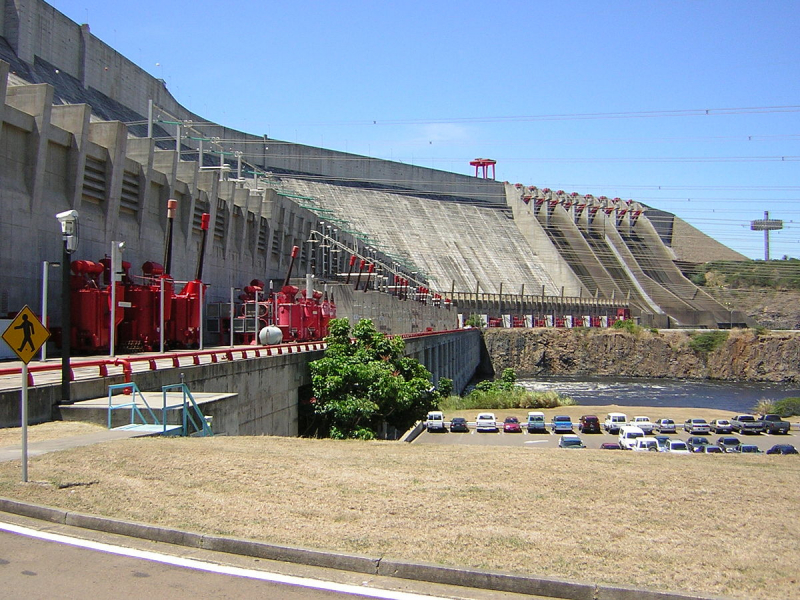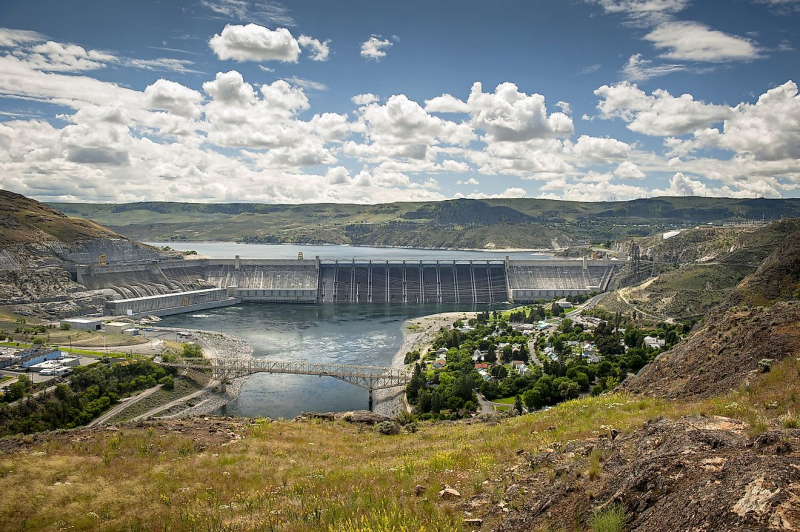Top 10 Biggest Hydroelectric Power Plants
With a total installed capacity of more than 1,307GW, hydropower is the world's largest source of renewable energy generation. According to a survey by the ... read more...International Energy Agency, it is likely to be the largest source between 2019 and 2024. The following list will give you the world's largest hydroelectric power stations ranked by electricity generation capacity.
-
The Three Gorges Dam power project, located on the Yangtze River in central China's Hubei Province, is the world's largest hydroelectric dam. The 2.3-kilometer-long concrete gravity dam is intended to prevent major floods in the Yangtze River's flood-prone upper reaches by directing them downstream. The power plant has a capacity of 22.5 GW and is equipped with 34 turbo generators. It has a 483-meter-long spillway, as well as a left and right powerhouse.
The $31 billion hydroelectric power project, which has been in operation since 2003, is the primary source of electricity in East China, Central China, Guangdong Province in South China, and other areas. In 2020, the Three Gorges Dam set a new world record for yearly power production from a single hydropower plant, generating 111.8 billion kilowatt-hours(kWh). It is owned by China Three Gorges Corporation (CTGC).
Location: Sandouping, Yiling District, Hubei, China
Construction began: December 14, 1994
Opening date: 2003
Electricity generation capacity: 22.5GW
Three Gorges Dam. Photo: britannica.com 
Three Gorges Dam. Photo: ipdefenseforum.com -
The Itaipu Binacional hydroelectric power station is located on the Parana River, which runs parallel to the Brazilian-Paraguayan border. It has a total capacity of 14 GW thanks to its 20 generating units. The power station, which is owned by the governments of Brazil and Paraguay, was built with 12.3 million cubic meters of concrete. The amount of steel and iron used in the project is enough to construct 380 Eiffel Towers.
The Itaipu dam, which is 7.23 kilometers long and 196 meters tall, is taller than a 55-storey building. In 2016, the power plant set a new global record for yearly electricity generation, producing 103.09 billion kilowatt-hours. The facility meets 15% of Brazil's energy consumption and 90% of Paraguay's energy usage, making it vital to both countries' energy demands. Since its commissioning in 1984, it has produced a total of 2.77 billion megawatt-hours (MWh) by the end of 2020. The plant will undergo technological modifications in order to increase its efficiency. Thanks to a long-term modernization program, the Itaipu power plant will be able to function responsibly for decades.
Location: Itaipu Dam is on the Alto (Upper) Paraná River at the Brazil-Paraguay border
Construction began: January 1971
Opening date: May 5, 1984
Electricity generation capacity: 14GW
Itaipu Dam. Photo: vi.wikipedia.org 
Itaipu Dam. Photo: en.wikipedia.org -
In 2014, the Xiluodu hydroelectric facility on China's Jinsha Jiang River became fully operational. The plant's 18 Francis turbine-generating units are distributed evenly between the left and right banks. Xiluodu Dam has a concrete double-curvature arch dam with a maximum dam height of 285.5m, making it the country's second-largest hydro project.
The project's main focal areas are power generation, flood management, and improving navigation conditions. To manage the river flow through the dam, the project features five huge control gates. The project, which is owned by China Yangtze Power, is one of the country's key renewable energy sources, helping the country satisfy its massive energy demand while cutting emissions and coal consumption. It creates 64 billion kilowatt-hours of renewable energy each year, which is supplied to China's State Grid and Southern Power Grid.
Location: Jinsha (Upper Yangtze) River, China
Construction began: December 2005
Opening date: July 2013
Electricity generation capacity: 13.86GW
Xiluodu. Photo: reduper.com 
Xiluodu. Photo: blog.sina.com.cn -
The Belo Monte hydropower project is located on the Xingu River in the Brazilian state of Para, in the Amazon rainforest. It generates enough power to meet 10% of Brazil's total energy consumption and the energy demands of 60 million people, with an installed capacity of 11.23GW. The installed capacity accounts for around 7% of the country's overall power production capacity.
With the activation of the 18th generating unit in November 2019, the facility has reached full operational capacity. The primary powerhouse contains 18 units of 611.11MW, while the supplementary powerhouse has six 38.85MW generating units. The power station was built with three million cubic meters of concrete and more than 160,000 tons of steel and is operated by the Norte Energia consortium under a 35-year concession term. Because the Itaipu plant is shared with Paraguay, Belo Monte is considered the country's largest 100%-owned hydro facility.
Location: Pará, Brazil
Construction began: 2011
Opening date: 2016
Electricity generation capacity: 11.23GW

Belo Monte. Photo: lifegate.com 
Belo Monte. Photo: dextragroup.com -
The Guri power plant, which is owned by C.V.G. Electrificacion del Caroni C.A. (EDELCA), opened in 1978 on the Caroni River in Bolivar State, Venezuela, with the activation of the first powerhouse with ten generating units. In 1985, a second powerhouse with ten additional units was completed.
The Guri plant, with a capacity of 10.23 GW, is essential to Venezuela's energy sector, supplying around 80% of the country's electricity. The plant's life was extended by 30 years thanks to a modernization program. It aimed to improve the project's control, protection, and instrumentation systems. The Venezuelan government and the World Bank jointly funded Guri, commonly known as the Simon Bolivar Hydroelectric Plant. The concrete gravity and embankment dam is 7.42 kilometers long and 162 meters tall, with a reservoir of around 4,600 km2. Droughts have impacted power output in the country on various occasions over the years.
Location: Necuima Canyon, Bolivar, Venezuela
Construction began: 1963
Opening date: 1978
Electricity generation capacity: 10.2GW
Guri. Photo: gody.vn 
Guri. Photo: en.wikipedia.org -
The Tucurui dam, located on the Tocantins River in Para, Brazil, has an 8.37 GW power generation capacity. This hydroelectric power plant has been in operation since 1984 and provides about 8% of the country's overall energy demands.
The project, which is being built in two parts, focuses on power generating and improving navigation. Eletronorte, a power generation, and transmission firm operate the 25-unit project, which is the first big hydroelectric power plant in the Brazilian Amazon jungle. The first phase of development was finished in 1984, and the second phase, which included an extra powerhouse, was completed in 2010. The first phase resulted in the creation of 14 generation units, with the second phase adding an additional 11 units.
Location: Tucuruí, Pará, Brazil
Construction began: 1975
Opening date: 1984
Electricity generation capacity: 8.37GW
Tucurui. Photo: en.wikipedia.org 
Tucurui. Photo: largest-dams-2.blogspot.com -
The Grand Coulee Dam, with a capacity of 6.8 GW, is the largest hydropower plant in the United States. It is one of the world's largest concrete structures and is located on the Columbia River west of Spokane, Washington.
The power plant has four powerhouses, the largest of which is the Nathaniel Washington Power Plant, which produces up to 21 billion kilowatt-hours of electricity every year. The main goals of Grand Coulee, which was built as part of the larger Columbia Basin Project, are hydropower, irrigation, and flood control. Franklin D. Roosevelt Lake, three power plants, a pump-generating facility, and four switch-yards are all part of the Columbia Basin Project. Idaho, Nevada, Washington, Oregon, Arizona, California, Wyoming, Montana, Utah, New Mexico, and Colorado receive power generated by the project. The Grand Coulee Dam project provides electricity to 4.2 million residences in the United States each year.
Location: the Columbia River west of Spokane, Washington, USA
Construction began: July 16, 1933
Opening date: June 1, 1942
Electricity generation capacity: 6.8GW

Grand Coulee. Photo: en.wikipedia.org 
Grand Coulee. Photo: worldatlas.com -
The 6.44GW Xiangjiaba hydroelectric project, located on the Jinsha River, a tributary of the Yangtze River in southwest China, produces 30.7 billion kilowatt-hours per year. It is owned by CTGC and is equipped with GE's 800MW Francis turbines. The facility, together with the Three Gorges Reservoir, is responsible for flood management in the Yangtze River's midstream and downstream sectors.
The first generator was installed in 2012, and the last generator was installed in 2014. The generated electricity is sent to Shanghai via the 2,000km-long, 800kV Xiangjiaba-Shanghai Ultrahigh Voltage Direct Current (UHVDC) link. The link has a system voltage that is 33% higher than the Itaipu transmission line. The UHVDC is one of the world's longest transmission lines.
Location: Yunnan, China
Construction began: November 26, 2006
Opening date: 2012
Electricity generation capacity: 6.44GW

Xiangjiaba. Photo: ejatlas.org 
Xiangjiaba. Photo: reduper.com -
On the Hongshui River in China's Guangxi Zhuang Autonomous Region, the Longtan hydroelectric power station is located. It is an important part of China's West-East Electricity Transmission Project, which focuses on developing power resources in the western region and transferring electricity to the provinces of Jiangsu, Zhejiang, and Guangdong, as well as Shanghai, Beijing, and Tianjin, which are experiencing electricity shortages.
Longtan's 216.5-meter-high, 836-meter-long roller-compacted concrete (RCC) gravity dam has a 27.3-billion-cubic-meter water storage capacity and a 7-billion-cubic-meter flood control storage capacity. The power plant has a yearly capacity of 18.7 billion kilowatt-hours of electricity. The dam, power plant, and ship locks were all built as part of the project. In 2008, the plant's first phase, which had seven generators with a total capacity of 700 MW, became fully operational. In 2009, the ninth and last generator became fully operational.
Location: Tian'e County, Guangxi, China
Construction began: 2001
Opening date: 2009
Electricity generation capacity: 6.42GW
Longtan. Photo: reduper.com 
Longtan. Photo: touristlink.com -
On the Yenisei River, the 6.4GW Sayano-Shushenskaya hydroelectric power facility is Russia's largest hydropower plant. RusHydro, a hydroelectricity corporation, manages the facility. Its 242m-high arch-gravity dam has a 1.06km crest length and a 25m crest width.
When one of the turbines of the Sayano-Shushenskaya plant failed in 2009, the building is flooded, killing 75 people and spilling 40 tons of oil into the Yenisei River. The plant came under fire. All ten turbines were damaged in the disaster, with at least three of them destroyed. In the aftermath of the accident, the factory was modernized with the installation of an enhanced vibration monitor as well as other safety precautions. Following the accident, the facility was temporarily shut down, resulting in a loss of 2.5 percent of Russia's electrical production. Although the plant resumed operations in February 2010, the repairs were completed by November 2014.
Location: Sayanogorsk, Khakassia, Russia
Construction began: 1963
Opening date: 1978 – 1985
Electricity generation capacity: 6.4GW

Sayano-Shushenskaya Dam. Photo: vi.wikipedia.org 
Sayano-Shushenskaya Dam. Photo: russiatrek.org






























